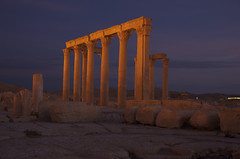Bikes have landed, thousands of them; they're all over town. With their distinct bi-color paint job of light and dark blue, they're hard to miss. Their swan neck frame recalls lady cyclists' dreams of the early 20th century, yet the bikes are brand new – and for everyone, not just the female aristocracy of yore. They are the vanguard of the Cycle Hire scheme that was rolled out yesterday. Nearly five thousand bikes have been docked to about 300 newly built stations all over the central part of the capital, roughly covering zone 1 of the London Underground system. More are on their way, both bikes and docking stations.
The bikes can be hired, at first by registered users only but later by anyone fancying a cruise through town, in the simplest possible way. Insert your key into the dock if you're a registered user or a credit card otherwise, pull the bike out and off you go. Don't forget to adjust the seat before you pedal off – and don't leave your key or card behind. When you don't need the bike any more, dock it to the nearest station, anywhere in central London. The system is designed to encourage quick direct trips. Usage fees, which are waived for registered users for the first half hour, climb steeply after thirty minutes and quickly become prohibitive. You wouldn't want to take a bike out for a Sunday in Richmond Park, but for a one-way trip from work into town (or to the station if you're a commuter) they're perfect.
Overall, there is real enthusiasm about Cycle Hire. The Evening Standard spends two pages every day interviewing early adopters and highlighting the benefits of the scheme. It will put more cycles on the road, increasing the strength in numbers that's the most effective safety feature cyclists have, and more people on bikes. It will slow down traffic, ease the strain on public transport and change the face of the city a little bit. It will give the streets back to Londoners. The ease and low cost of use might nudge people to give bikes a try and help them see that despite being a frantic metropolis, London is not a scary place to ride.
The hype has worked; the bikes are being used. On the first day of operation, some stations looked raided of bikes, with only one two remaining, whereas others were jam packed. It's all part of the continuous redistribution that will see the bikes ebb and flow through the capital. As I have a bike already and live outside the zone covered by the system, I was doubtful about Cycle Hire at first. But I was won over by the idea of having a ride ready wherever, whenever, and signed up a few days ago. Earlier this week, I got my key in the mail (though I haven't hired a bike yet).
Walking home from the shard on Kensington High Street that houses one of the nicer Caffè Neros, I'm having second thoughts. There are plenty of docking stations just off the high street, but in the side streets, I'm walking block after block without encountering one. If I'm going into an area I don't know, how will I find one? There are surely nifty applications for smartphones, but what about old-school communicators? Will we have to memorize the whole system map?
These are the question that come to my mind, but there are apparently other, more serious issues. It turns out that the reason for the bikes' color is Barclays. The bank shelled out 25 million pounds to help finance the system (and put its name on it). When the first bikes appeared in their docking stations, an ill-defined group of "anti-war protestors" defaced them with cans of black spray paint. Barclays also "funds cluster bombs and radioactive material that causes birth defects", claim the protesters. But even if there were sense in these illogic words, how does breaking bikes promote world peace or hurt Barclays? I guess smashing the windows of bank branches takes more courage than the protesters have.
In an entirely unrelated story, two supercars in a matching monochromatic paint job of a blue roughly halfway between the two bicycle blues were spotted outside Harrods the other day. Their swooshing shapes and roaring engines recall gearheads' dreams of now, yet the cars, a Koenigsegg CCXR and a Lamborghini Murciélago LP670-4, are for certain members of the al-Thani familiy only. Though the al-Thanis, the rulers of Qatar, are the proud new owner of Harrods, having bought the little store off Mohamed al-Fayed a few months ago, they have no special parking prerogatives next to their new property. The two cars, worth over 1.5 million pounds between them, were promptly clamped by an eager traffic warden. If the Cycle Hire key released them, I'd cruise over in a second.
